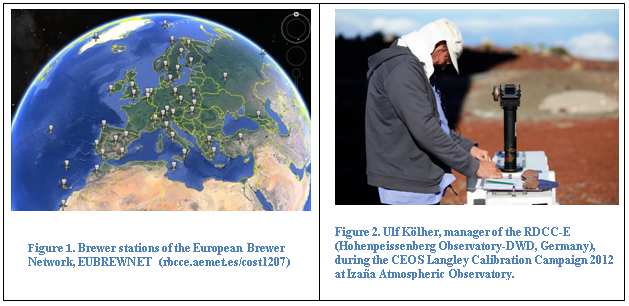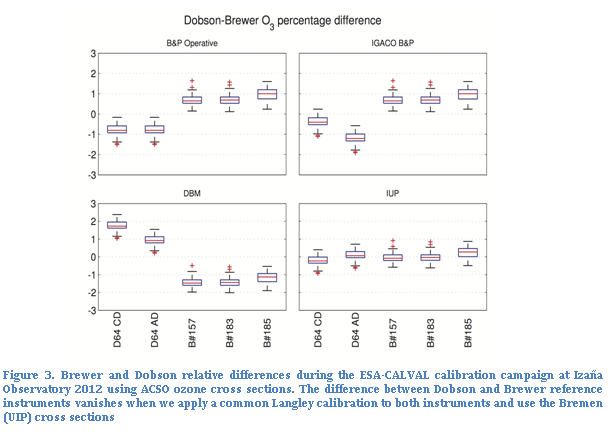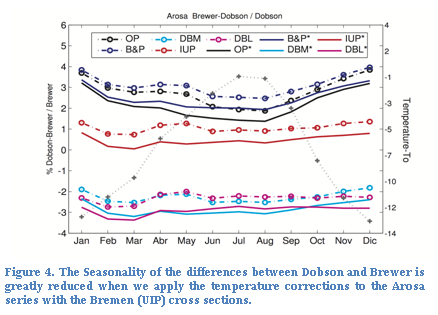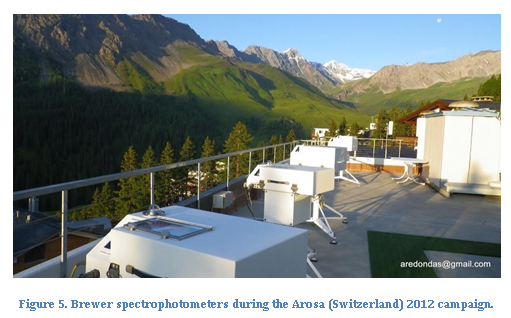The novel study entitled “Evaluation of the Use of Five Laboratory Determined Ozone Absorption Cross Sections in Brewer and Dobson Retrieval Algorithms” published in Atmospheric Chemistry and Physics

The work entitled “Evaluation of the Use of Five Laboratory Determined Ozone Absorption Cross Sections in Brewer and Dobson Retrieval Algorithms” has been published in Atmospheric Chemistry and Physics. This work evaluates the effect of using ozone cross sections presented at ACSO committee (Absorption Cross Section of Ozone) on the ground-based reference instruments Dobson and Brewer.

The routine measurement of total ozone started in the mid-1920s with a prototype of the Dobson instrument, until the late 1970s, this was the only instrument measuring Ozone. The Brewer Ozone Spectrometer was developed in Canada during the 1970s, and wide available in the 1980’s. As observing organizations purchased these instruments and placed them in service alongside the Dobson instrument, the seasonal and systematic bias in the results became evident. The initial difference of 4 % was removed with the adoption of absorption coefficients of a common ozone cross section in early 1090’s but seasonal and offset difference was still evident. With the consideration of the replacement of the manually operated Dobson with automated Brewer, some “transfer function” schemes were considered recently. These methods can be quite successful, but do not fully explain the reasons for the differences.
The difference in the results of measurements made in the same place is not limited to the primary ground based networks. In 2009, the ozone community established the ACSO committee (“Absorption Cross Sections of Ozone”) to review the presently available XS databases and to determine the impact of a change of the reference XS for the different instrument types (ground-based and satellite) used in the individual instrument retrieval algorithms. (http://igaco-o3.fmi.fi/ACSO/). This ASCO committee is a joint commission of Scientific Advisory Group (SAG) of the Global Atmosphere Watch (GAW) of the World Meteorological Organization (WMO) and the International Ozone Commission IO3C) of the International Association of Meteorology and Atmospheric Sciences (IAMAS).
The paper demonstrates that the use of recently released Ozone Absorption Cross Section by Bremen University solves the historical differences between Dobson and Brewer spectrophotometers, the primary ground-based instruments to measure Total Ozone. The application of this new cross sections to the CEOS Calibration campaign data of reference instruments vanishes the bias between the Ozone measurements of these two instruments, moreover introducing the temperature dependence of the cross section on the retrieval algorithms the seasonal differences of these instruments also disappear when we apply to the Arosa Switzerland Dobson and Brewer simultaneous total ozone observations.



The reference of the article is:
Redondas, A., Evans, R., Stuebi, R., Köhler, U., and Weber, M.: Evaluation of the use of five laboratory determined ozone absorption cross sections in brewer and dobson retrieval algorithms, Atmos. Chem. Phys. Discuss., 13, 22979-23021, doi:10.5194/acpd-13-22979-2013, 2013.
The article can be download at:
http://www.atmos-chem-phys-discuss.net/13/22979/2013/acpd-13-22979-2013.html





